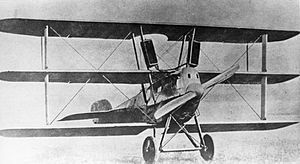| Hansa-Brandenburg L.16 | |
|---|---|

| |
| Role | FighterType of aircraft |
| Manufacturer | Hansa-Brandenburg |
| First flight | 1917 |
| Status | Prototype |
| Primary user | Austro-Hungarian Empire |
| Produced | 1917 - 1918 |
| Number built | 1 |
The Hansa-Brandenburg L.16, was an experimental triplane fighter that was designed in the Austro-Hungarian Empire during the First World War.
Specifications (Hansa-Brandenburg L.16)
Data from
General characteristics
- Crew: 1
- Length: 7.17 m (23 ft 6 in)
- Upper wingspan: 9 m (29 ft 6 in)
- Mid wingspan: 9 m (29 ft 6 in)
- Lower wingspan: 9 m (29 ft 6 in)
- Height: 2.82 m (9 ft 3 in)
- Wing area: 33.5 m (361 sq ft)
- Empty weight: 740 kg (1,631 lb)
- Gross weight: 935 kg (2,061 lb)
- Powerplant: 1 × Austro-Daimler 185hp 6-cylinder water-cooled in-line piston engine, 138 kW (185 hp)
Performance
- Maximum speed: 190 km/h (120 mph, 100 kn)
- Time to altitude: 1,000 m (3,300 ft) in 1 minute
- 2,000 m (6,600 ft) in 3 minutes
Armament
- Guns: 2 × fixed, forward-firing 8 mm (0.315 in) Schwarzlose machine guns
References
- ^ Grosz, Peter M.; Haddow, George; Scheiner, Peter (2002) . Austro-Hungarian Army Aircraft of World War One. Boulder: Flying Machine Press. pp. 425–426. ISBN 1-891268-05-8.
Further reading
- Gray, Peter; Thetford, Owen (1970). German Aircraft of the First World War (2nd ed.). London: Putnam. ISBN 978-0-370-00103-6.
External links
| Hansa-Brandenburg aircraft | |
|---|---|
| Austro-Hungarian military designations | |
| Company designations | |